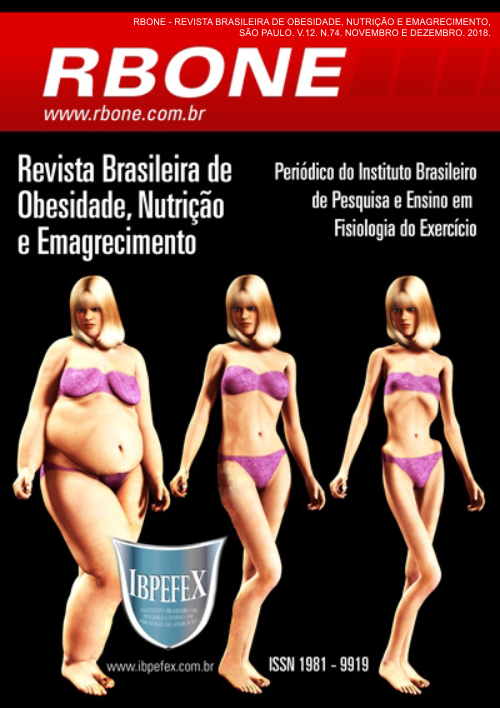Prevalence of orthorexia nerve in academic nutrition course in an institution of higher education in Paraná southwestern
Abstract
This study aims to determine the presence of Orthorexia Nervosa Nutrition Course students at a higher education institution in southwestern Paraná. The sample consisted of 82 students, 77 women and 5 men. They were applied 2 questionnaires, a socioeconomic and another called Ortho-15. According to the data obtained most academics, 80% (n = 66) showed prevalence for ortoróxico behavior. Of the variables analyzed the physical activity factor is most connected to Orthorexia (p <0.0001), followed by BMI value (p <0.0358), where the lower the BMI value greater propensity to behavior. Regarding gender, all male participants showed ortoróxico behavior, female participants amounted to 92% (n = 65) percentage. The Orthorexia Nervosa is an abnormal eating behavior and if not diagnosed quickly can lead to severe damage to physical and mental health. With the positive results of the proposed study, it is suggested that further research be conducted in order to define the profile of the Brazilian population for the prevalence of behavior. Feels the need for a review in Orto-15 questionnaire, since it presents dubious interpretations questions and could jeopardize the actual result.
References
-Alvarenga, M.S.; Martins, M.C.; Sato, K.S.; Vargas, S.V.; Philippi, S.T.; Scagliusi, F.B. Orthorexia nervosa behavior in a sample of Brazilian dietitians assessed by the Portuguese version of ORTO-15. Eat Weight Disord. Vol. 17. Núm. 1. p. 29-35. 2012.
-Amaral, C.O.F.; Dias.; R.V.; Ferreira, M.F.A.C.R.; Parizi, A.G.S.; Oliveira, A. Estudo da relação entre transtornos alimentares e saúde bucal. Arch Oral Res. Vol. 7. Núm. 2. p. 205-15. 2011.
-Bratman, S. Original essay on orthorexia. [Internet]. 1997. [acesso em 02 jun. 2016]. Disponível em: <http://www.orthorexia.com/index.php?page=essay>.
-Donini, L.M.; Marsili, D.; Graziani, M.P.; Imbriale, M.; Cannella, C. Orthorexia nervosa: a preliminary study with a proposal for diagnosis and an attempt to measure the dimension of the phenomenon. Eat Weight Disord. Vol. 9. Núm. 2. p. 151-7. 2004.
-Fidan, T.; Ertekin, V.; Işikay, S.; Kirpinar I. Prevalence of orthorexia among medical students in Erzurum, Turkey. Comprehensive Psychiatry. Vol. 51. Núm. 1. p. 49-54. 2010.
-Lopes, M.R.; Kirsten, V.R. Comportamentos de Ortorexia Nervosa em mulheres jovens. Disciplinarum Scientia. Série: Ciências da Saúde. Vol. 10. Núm. 1. p. 97-105. 2009.
-Luna, C.A.; Belmonte, T.S.A. Ortorexia nervosa: um desafio para o nutrólogo. International Journal of Nutrology. Vol. 9. Núm. 1. p.128-139. 2016.
-Martins, M.C.T.; Alvarenga, M.S.; Vargas, S.V.A.; Sato, K.S.C.J.; Scagliusi, F.B. Ortorexia nervosa: reflexões sobre um novo conceito.Rev. Nutr. Campinas. Vol. 24. Núm. 2. p. 345-357. 2011.
-Nassau, B.O.P. Prevalência de Ortorexia Nervosa em estudantes de Nutrição da Universidade Católica de Brasília. TCC. Brasília. Universidade Católica de Brasília. 2012.
-Organização das Nações Unidas-ONU Mulheres. O valente não é violento. Planos de aula.2015.
-Pontes, J.B.; Montagner, M.I.; Montagner, M.A. Ortorexia nervosa: adaptação cultural do orto-15. Rev. Demetra: Alimentação, nutrição & saúde. Vol. 9. Núm. 2. p. 533-548. 2014.
-Pontes, J.B. Ortorexia em estudantes de nutrição: a hiper correlação incorporada ao habitus profissional? Dissertação de Mestrado. Brasília-DF. Universidade de Brasília. Faculdade de Ciências da Saúde. Programa de Pós-Graduação em Ciências da Saúde. 2012.
-Souza, Q.J.O.V.; Rodrigues, A.M. Comportamento de risco para ortorexia nervosa em estudantes de nutrição. J. Bras de Psi. Vol. 63. Núm. 3. p. 200-204. 2014.
-Vilela, J.E.M.; Lamounier, J.Á.; Filho, M.A.D.; Neto, J.R.B.; Horta, G.M. Transtornos alimentares em escolares. Jornal de Pediatria. Vol. 80. Núm. 1.2004.
-World Health Organization. Obesity. Preventing and managing the global epidemic. Report of a WHO consultation on obesity. WHO/NUT/NCD/981. WHO. Geneva. 1998.
Authors who publish in this journal agree to the following terms:
- Authors retain the copyright and grant the journal the right of first publication, with work simultaneously licensed under the Creative Commons Attribution License BY-NC which allows the sharing of the work with acknowledgment of the authorship of the work and initial publication in this journal.
- Authors are authorized to enter into additional contracts separately for non-exclusive distribution of the version of the work published in this journal (eg, publishing in institutional repository or book chapter), with acknowledgment of authorship and initial publication in this journal.
- Authors are allowed and encouraged to post and distribute their work online (eg, in institutional repositories or on their personal page) at any point before or during the editorial process, as this can bring about productive change as well as increase impact and impact. citation of published work (See The Effect of Free Access).






